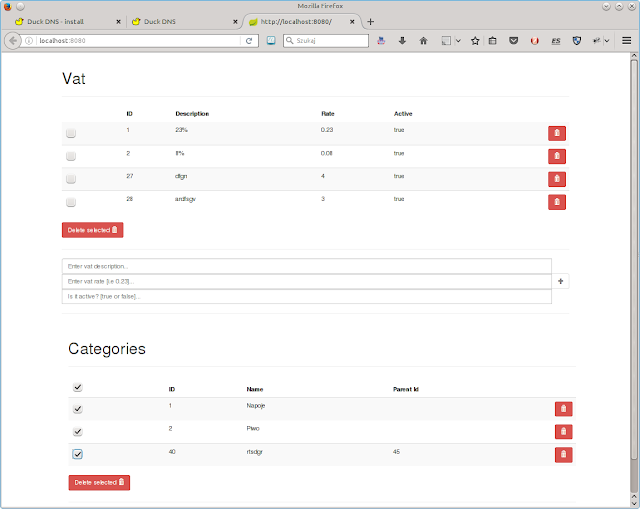I have normal entity productOnStock.
I need to have custom view for this entity for normal user.
To do this follow these steps.
Create folder /src/main/webapp/app/manager/stock/
Copy from /src/main/webapp/app/entities/product-on-stock/ files:
product-on-stocks.html
product-on-stock.state.js
product-on-stock.service.js
product-on-stock.search.service.js
product-on-stock.controller.js
3. Paste them into /src/main/webapp/app/manager/stock/
4. Change their names from product-on-stocks.* to stock.*
5. In stock.service.js:
change: .factory('ProductOnStock', ProductOnStock);
to: .factory(‘Stock', Stock);
-------------------------------
ProductOnStock.$inject = ['$resource', 'DateUtils'];
to: Stock.$inject = ['$resource', 'DateUtils'];
--------------------------------
function ProductOnStock ($resource, DateUtils) {
var resourceUrl = 'api/product-on-stocks/:id';
to:
function Stock ($resource, DateUtils) {
var resourceUrl = 'api/stock/:id';
6. In stock.state.js:
Change:
.state('product-on-stock', {
parent: 'entity',
url: '/product-on-stock',
data: {
authorities: ['ROLE_USER'],
pageTitle: 'barfitterApp.productOnStock.home.title'
},
views: {
'content@': {
templateUrl: 'app/entities/product-on-stock/product-on-stocks.html',
controller: 'ProductOnStockController',
controllerAs: 'vm'
}
},
resolve: {
translatePartialLoader: ['$translate', '$translatePartialLoader', function ($translate, $translatePartialLoader) {
$translatePartialLoader.addPart('productOnStock');
$translatePartialLoader.addPart('global');
return $translate.refresh();
}]
}
})
to:
.state('stock', {
parent: 'manager',
url: '/stock',
data: {
authorities: ['ROLE_MANAGER'],
pageTitle: 'barfitterApp.productOnStock.home.title'
},
views: {
'content@': {
templateUrl: 'app/manager/stock/stock.html',
controller: 'StockController',
controllerAs: 'vm'
}
},
resolve: {
translatePartialLoader: ['$translate', '$translatePartialLoader', function ($translate, $translatePartialLoader) {
$translatePartialLoader.addPart('productOnStock');
$translatePartialLoader.addPart('global');
return $translate.refresh();
}]
}
})
Comment other states for now.
7. In stock.controller.js
change:
.controller('ProductOnStockController', ProductOnStockController);
ProductOnStockController.$inject = ['$scope', '$state', 'ProductOnStock', 'ProductOnStockSearch'];
function ProductOnStockController ($scope, $state, ProductOnStock, ProductOnStockSearch) {
to:
.controller('StockController', StockController);
StockController.$inject = ['$scope', '$state', 'ProductOnStock', 'ProductOnStockSearch', 'Stock'];
function StockController ($scope, $state, ProductOnStock, ProductOnStockSearch, Stock) {
----------------
change:
function loadAll() {
ProductOnStock.query(function(result) {
to:
function loadAll() {
Stock.query(function(result) {
8. In stock.search.service.js change:
.factory('ProductOnStockSearch', ProductOnStockSearch);
ProductOnStockSearch.$inject = ['$resource'];
function ProductOnStockSearch($resource) {
var resourceUrl = 'api/_search/product-on-stocks/:id';
to:
.factory('StockSearch', StockSearch);
StockSearch.$inject = ['$resource'];
function StockSearch($resource) {
var resourceUrl = 'api/_search/stock/:id';

